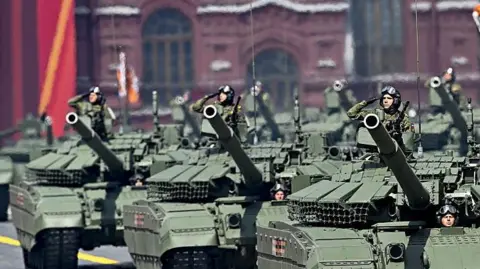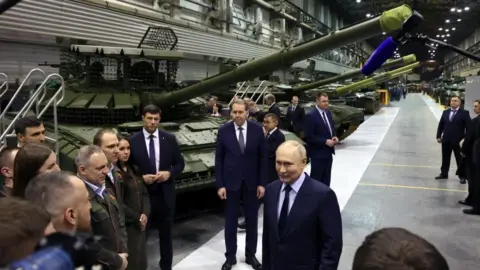Business reporter
 Getty Images
Getty ImagesSince its illegal invasion of Ukraine in 2022, Russia has become the most sanctioned nation on Earth, and yet its economy has been remarkably resilient.
In 2024, if Russian official figures are to believed, its economy outgrew those of all the G7 nations – Canada, France, Germany, Italy, Japan, the UK, and the US.
The Russian economy expanded by 4.3% last year, compared with 1.1% in the UK, and 2.8% in the US.
This growth in Russia was led by the Kremlin’s record military spending.
The country’s oil exports, by volume, have also remained relatively stable, as supplies once destined for Europe have been diverted to China and India.
And a “shadow fleet” of tankers, whose ownership and movements could be obscured, has helped Moscow circumvent sanctions elsewhere.
Meanwhile, the Russian rouble has recovered to become the best-performing world currency this year, with gains of more than 40%, according to Bank of America.
Yet, as we move towards 2026, the mood music is changing.
Inside the country inflation has been persistently high, interest rates have soared to 20%, and companies can’t find the workers they need. And globally, oil prices had fallen back this year before the current conflict between Israel and Iran caused a spike.
Russia’s economy minister warned on Thursday that the country was “on the verge” of recession after a period of “overheating”.
And some Russia watchers have even suggested the economy could be headed for collapse.
But how likely is that really? And how does it affect the course of the war?
Yevgeny Nadorshin, an economist based in Moscow, tells BBC News: “Overall, it will be a pretty uncomfortable situation until late 2026, and definitely there will be defaults and bankruptcies.”
But he predicts the downturn will be “mild” and calls any suggestion of a meltdown a “total lie”.
“Without any single doubt, the Russian economy has experienced a number of recessions deeper than this.”
Mr Nadorshin points out that Russia’s unemployment rate is currently at a record low of 2.3%, and will probably peak at just 3.5% next year. By contrast, the UK’s unemployment rate was 4.6% in April.
 Getty Images
Getty ImagesStill, he and others see reasons for concern, and that’s because Russia appears to have entered a period of stagnation.
Its inflation rate was 9.9% in the year to April, partly due to Western sanctions pushing up the price of imports, but also because of worker shortages which have driven up wages.
The country lacked around 2.6 million workers at the end of 2024, according to Russia’s Higher School of Economics, largely due to men going to war or fleeing abroad to avoid it.
The central bank put interest rates up to record levels this year to try and tame the rising prices – but it’s making it more costly for companies to raise the capital they need to invest.
Meanwhile, Russia’s oil and gas revenues have fallen due to sanctions and weaker pricing, and were down by 35% year-on-year in May, according to official figures.
It has contributed to a widening budget shortfall that has left the country with less to spend on infrastructure and public services.
“They have this large pot of expenditure for the military that can’t be touched,” says András Tóth-Czifra, a political analyst and Russia watcher. “So it means money is starting to be reallocated from vital investment projects in road, rail and utilities.
“The quality of provision is really suffering.”
Russia may have coped better than expected with Western sanctions, but they continue to drag on the economy, he adds.
Russian companies are struggling to import the technology they need, and it has badly damaged the car industry. The EU has also banned imports of Russian coal and diversified away from its gas with a view to phasing out imports by 2027.
“None of this is likely to seriously impede Russia’s ability to wage war in the short-term,” says Mr Tóth-Czifra. “But it could affect the economy’s ability to grow or diversify in years to come.”
So far the Kremlin has brushed off the concerns. In early June, spokesman Dmitry Peskov told reporters that the “macroeconomic stability” and “underlying strength” of the Russian economy were plain to see.
In April, meanwhile, he said the economy was “developing quite successfully” thanks to government policies.
 Getty Images
Getty ImagesIt is hard to say what will happen next.
If Ukraine and Russia reach a peace deal this year, which is not unfeasible, it would relieve some of the pressure on Moscow. US President Donald Trump has stated his desire to normalise relations and even forge new economic partnerships.
But Europe may well “stay the course” and maintain its own sanctions in the event of peace, says Dr Katja Yafimava from the Oxford Institute for Energy Studies.
“Even if it doesn’t, it’s next to impossible to see a sort of big return to Europe buying Russian oil and gas as was the case before 2022, although a modest return of gas imports is possible,” she adds.
“Still, this would paint a difficult economic picture for Moscow. While Russia has mostly re-orientated its oil exports away from Europe, it is more difficult to do so for gas.”
Whatever happens, it looks like the war will have long-term costs for Russia – and the Kremlin is running out of ways to offset them.







